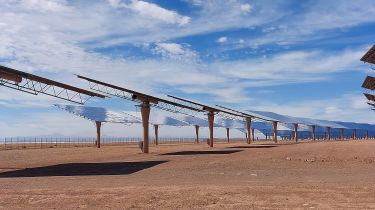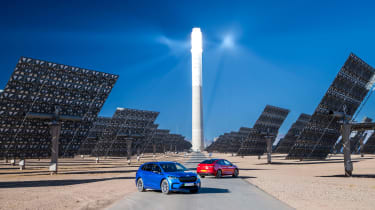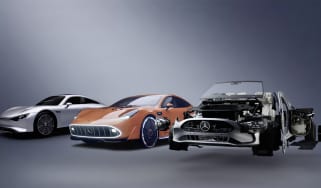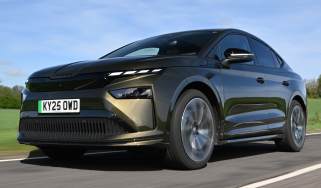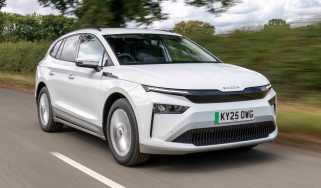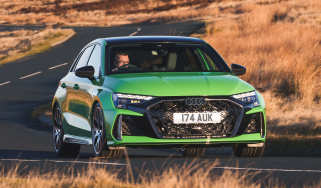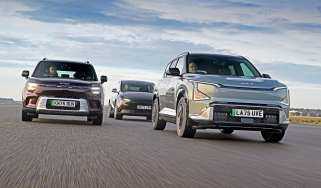Can Saharan solar power drive the hydrogen car revolution?
We take a Skoda Enyaq EV to the Sahara via the world’s biggest concentrating solar power station for a glimpse at potential future of green hydrogen production
My first ‘proper’ electric car was an r/c Tamiya Sand Scorcher, and I still remember the disappointment of reading in the manual that playing with it on actual sand dunes would destroy the running gear and motor. There are no such issues with the electric Skoda Enyaq SUV, which I’ve just driven 500kms without incident from the Noor solar station in Ouarzazate, Morocco, to the fringes of the Sahara desert and back.
The trip was mostly designed to showcase the qualities of Skoda’s range-topping battery-powered EV. Comfortable, refined and fast on lightly-trafficked roads with surfaces that put much of the UK’s pockmarked tarmac to shame, the roomy 4x4 Enyaq also takes sandy Saharan tracks in its stride. And in case we didn’t quite believe the ease with which it coped, our Skoda hosts introduced us to a couple of intrepid Dutch adventurers who have recently returned from a 40,000kms ‘circumnavigation’ of Africa at the wheel of their own electric Enyaq.
Amazingly Maarten van Pel and Renske Coxå didn’t encounter a single mechanical problem en route, despite 30 percent of their journey being off-tarmac. Range anxiety isn’t a thing either, when you can unpack an array of solar panels that will fast charge the battery at close to 11kW.
While plenty of people remain unconvinced of the benefits of battery-powered EVs, it’s increasingly hard to argue they can’t get the job done. But there’s also a cohort of disaffected drivers who think they can hang on a bit longer and skip the battery EV phase altogether, because ‘hydrogen is coming’ at some still-to-be-defined moment in the future.
As a fuel cell enthusiast I empathise with that aspiration, and look forward to a day when planet earth is heated and powered by a limitless source of renewable hydrogen. While it would be foolish to think that’s happening anytime soon, our visit to Noor provided a tantalising glimpse of the tech that’s poised to start the ball rolling.
Noor is the site of the Moroccan energy ministry’s world-leading solar power complex that provides electricity for over two million of its citizens with an output of circa 580 megawatts. It generates electricity via a combination of photovoltaic solar panels, and by using mirrors that concentrate energy into ‘molten salt’ heat transfer fluid (HTF), which is then used to heat water in steam turbine electricity generators.
At the heart of the station, and at the centre of concentric rings of 7,400 heliostat mirrors each the size of a tennis court, is Noor’s 240m tall solar power tower. The mirrors follow the sun like petals on a sunflower, and focus heat on a special composite material at the top of the tower where molten salt can be heated to a startling 580 degrees C. The special properties of the HTF mean it retains that heat for up to seven hours, so Noor can continue to generate electricity through the night when the sun doesn’t shine. It’s the biggest solar plant of its type in the world, and a stunning sight - the heat collector at the top of the tower appears to glow with almost incandescent intensity as it soaks up the concentrated sun rays. We don’t go in much for ‘wonders of the world’ these days, but if we did the epic Noor solar tower would be a shoe-in.
There’s no plan to use energy from Noor itself to electrolyse green hydrogen, but cutting-edge solar stations of this type are critical to the planet’s renewable ambitions. Given its proximity to Europe, Morocco itself has major ambitions when it comes to producing hydrogen as our ‘fuel of the future’, and as recently as December 2023 the EU signed an energy energy deal with Morocco that provides 50 million Euros to fund R&D in energy tech, including green hydrogen production.
We caught up with Noor plant director Mustapha Sallem, who explained Morocco’s potential as a global hydrogen producer and exporter.
“The position of Morocco is very strategic. We have 75 per cent of the world’s phosphate resources, more than 2,500kms of Atlantic coastline and 500 kms of Mediterranean coast, and we are very close to Europe,” he told us, making the point that water is critical to the production of green hydrogen while phosphate is necessary to produce ammonia, currently favoured as a potentially effective means to transport green energy around the the globe as it can be processed again in local markets to release its stored hydrogen. “We have very good conditions in order to produce hydrogen, and we have a demand from Europe. So, it would be silly not to profit from that position as it’s a huge potential opportunity for Morocco,” Sallem said. “Everybody is interested in that at that moment, and it is the future, absolutely.”
What neither Sallem, or anyone else can accurately say, is how long it’s going to take to get there. Morocco is not the only renewables-rich nation looking for a piece of the global hydrogen pie, either, but its proximity to Europe makes it a strong contender for becoming a green energy ‘superpower’. It’s not hard to imagine a handful of Noor-style solar stations dotted around the Moroccan coastline providing the energy for hydrogen electrolysis, although the necessary billions of investment aren’t chickenfeed, aside from the technical challenges.
Of course, we don’t do a bad job of generating renewable energy here in the UK from wind, and while there’s a consensus that the planet needs hydrogen to fuel industry, heavy trucking, rail and shipping in future, the jury is still out on when, and indeed whether, it will compete as a viable fuel for mainstream personal transport in fuel cell cars. Battery tech is developing rapidly in its own right, and as our little Saharan odyssey so effortlessly proved, you can already drive an Enyaq confident that it will live up to the challenges of everyday driving - wherever your commute might take you.
Is hydrogen the fuel of the future? Tell us your thoughts in the comments section below...

